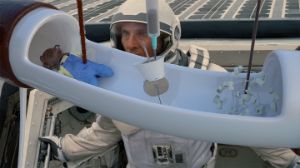
Cinema
The New Infinity Cinema
With films by Jeremy Shaw, Ana Vaz, Andrew Norman Wilson, Jane Jin Kaisen and Cyprien Gaillard. Curated by Agnieszka Polska.

Ode to Seekers 2012 © Andrew Norman Wilson
Where does the growing interest in experiencing one’s own demise and the demise of the world in the most immersive way possible come from when dealing with works of art? For the first time, The New Infinity presents a film programme curated by the artist Agnieszka Polska for this occasion in the cinema hall of the Zeiss Large Planetarium. With their own narrative and poetics, the selected contributions react to the confrontation with an environment doomed to end. They are reports of dramatic experiences of transformation, of the circulation of substances and bodies as well as of immaterial streams of information. With films by Jeremy Shaw, Ana Vaz, Andrew Norman Wilson, Jane Jin Kaisen and Cyprien Gaillard.
Jeremy Shaw: Introduction to the Memory Personality
Part clandestine guided-hypnosis tape, part pseudo-psychoanalytical video questionnaire, “Introduction to The Memory Personality” sucks the viewer into a persuasive single-point-perspective on human consciousness and memory. Created specifically for the One on One exhibition at KW, Berlin, in 2012, (in which all works were made to only be viewed by one person at a time), the video’s VHS aesthetic serves as a levelling platform for an alchemical mix of neuroscience, motion-graphics, first-person POV, mind manipulation techniques, found footage collages and ominous narration recalling vague moments from a real or imagined past. “Introduction to The Memory Personality” assumes the role of thrift shop dollar-bin curio brought home, viewed, and lodged permanently somewhere in the back of your psyche.
Ana Vaz: Atomic Garden
“We could say that a firework is not different from a tree, or from a big artificial flower that grows, develops, flowers and dies in a few seconds. Withered, finally, it soon disappears in unrecognizable fragments. Well, let’s take this firework and make it last for a month, and we will have a flower with all the characteristics of other flowers. Or so, inverting the order of factors, may we imagine that the seed of a plant can explode like a bomb.” – Bruno Munari
Andrew Norman Wilson: Ode to Seekers 2012
“Ode to Seekers 2012” (2016) was the second project Andrew Norman Wilson developed in collaboration with the Romanian animator Vlad Maftei, and was initially conceived at Rockland Psychiatric Center in Orangeburg New York, which contains the abandoned children’s ward seen in the video. Loosely based on John Keats’ poem “Ode on a Grecian Urn” (1820), the work emerges from a translation of the formal techniques of Keats’ textual ode to an infinitely looping video. Ekphrasis—the graphic, dramatic description of a visual work of art—shifts from Keats’ urn and the celebratory scene it depicts to an abandoned children’s ward at a mental institution and a computer-generated scene composed by Wilson and Maftei. “What mad pursuit? What struggle to escape? What pipes and timbrels? What wild ecstasy?” The questions that Keats asks of the images on the urn are visually translated for the viewer of “Ode to Seekers”, transposing the poet’s queries to a scene in which a mosquito, a syringe, and an oil pump all thrust their piercers into a surface that looks at once like human skin under a microscope, desert salt flats, and potato casserole.
Jane Jin Kaisen: Strange Meetings
“Strange Meetings” was filmed at a former treatment facility for sexually transmitted diseases located near the DMZ in South Korea. The prevalence of STD among US soldiers stationed in Korea in the 1970s became a bilateral crisis and women who worked in the US military camptowns were often suspected of carrying STDs and some were forcibly detained in the center. While the building served to isolate bodies presumed contaminated from those deemed clean, the site today, however, materially bears witness to the entangled relations behind its establishment and the impossibility of creating neat separations. Beyond being an abandoned site in decay, the former STD center now serves as a backdrop for another strange meeting: A performance takes place behind the building each weekend, inadvertently complicating the relationship between past and present and diffusing the reading of the site by overriding but potentially also purging its history.
Cyprien Gaillard: Ocean II Ocean
As with much of Cyprien Gaillard's work, “Ocean II Ocean” (2019) connects disparate, evocative references into a concerto of images, sound, and movement. The film is divided into two sections that follow upon each other in an infinite loop. In the first, Gaillard’s camera focuses on fossils encrusted in the underground walls of metro stations in Russia and the former Soviet Bloc. The fossils speak to the prehistoric, watery histories of the sites that generated these materials. The other half of Ocean II Ocean follows MTA subway cars on a journey across tracks out to sea, ceremoniously dumped into the Atlantic Ocean, destined to become substrate for future reefs. Diving below the water’s surface, the camera captures marine animals moving among the steel carriages. The frenetic energy of the film’s soundtrack, produced by Gaillard from samples of recordings of a steel pan orchestra, connects these stainless steel carcasses with the percussive sound of steel. Known for their carnivalesque echoes, steel pans are historically from Trinidad and Tobago and traditionally made from discarded oil barrels, whose original contents relate both to the creation of fossil fuel and to the contemporary pollution and demise of underwater life. Connected both thematically and materially, Gaillard’s film makes apparent the recurring, tidal movements both of oceans and of the earth’s interactions with human history.
Jeremy Shaw: Introduction to the Memory Personality (2012, 12 min 38s)
Ana Vaz: Atomic Garden (2013, 8 min)
Andrew Norman Wilson: Ode to Seekers 2012 (2016, 8 min 30s)
Jane Jin Kaisen: Strange Meetings (2017, 4 min 55s)
Cyprien Gaillard: Ocean II Ocean (2019, 11 min)

